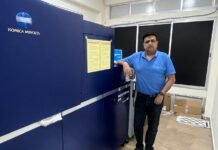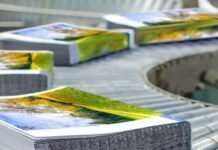Patna-based educational book printer Balajee Offset, which started operations in October 2017, is planning to upgrade its binding department by bringing in more automatic machines in order to enhance the efficiency of its finishing division. Balajee Offset currently prints only educational books using a Komori Lithrone A37 offset press, which the company bought brand new when it started operations two years ago.
“With the Komori Lithrone A37, our printing section has become extremely capable but we are facing a bottleneck in our binding sector, which is not able to cope up with the printing volumes. To overcome this issue, we will be bringing in more automatic machines. We will start installing these machines starting next financial year, which is March 2020,” says Amar Verma, proprietor of Balajee Offset.
At present, Balajee Offset’s binding department has basic Indian-made equipment, such as gluing machines, stitching machines, folding machines, and cutting machines. The company employs ten people in its printing and binding sections. Balajee Offset operates the press in one 12-hour shift every day for the full year.
Talking about his experience with Komori, Verma says that the two years have been very good not only because the quality of the Komori technology is exceptional but also because the after-sales service is up to the mark. “The best part about dealing with Komori is that whenever we have faced an issue and have requested assistance, the engineer is at our site within 12 hours,” he shares.
Although strengthening the binding sector is the topmost agenda in the near term, Verma shares that he may opt for another offset press one year down the line, instead of running the Komori Lithrone A37 for a 24-hour shift.
“Yes, as volumes grow, we will need to add capacity but our philosophy is that one press should be operated by one operator only. Therefore, if and when we need to increase our printing capacity, we will go for a new press rather than utilize the Lithrone A37 beyond its 12-hour shift. Anyway, we do not plan to buy another press for at least one more year,” Verma says.
Patna printers need to invest in technology
With the growth in the economy of Bihar in the last decade or so, print demand has also expanded, especially in Patna. However, Verma believes, printers in the city have not invested in technology and therefore are not able to offer quality work.
“Patna’s economy has grown multiple times in the last ten years and so it has the potential to become a printing hub. There is scope for growth in both educational book printing as well as commercial printing segments here. However, printers have not invested in technology and therefore the print quality that they offer is not up to the mark. There are just a handful of printers in such a big city who can offer quality. For example, there are just a few Komori offset presses here,” he says.
Verma argues that unless printers invest in quality, customers will keep on demanding basic work. Customers who want to get special work done opt to get it printed from printers in Delhi.
“Printers here have the impression that there is not enough work in Patna. However, there is room for many more quality printers. They will need to develop the market by offering quality. Customers will come,” Verma concludes.
















